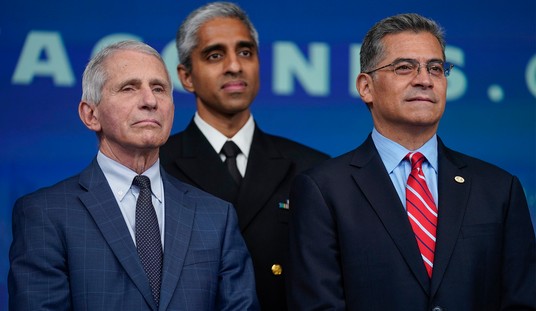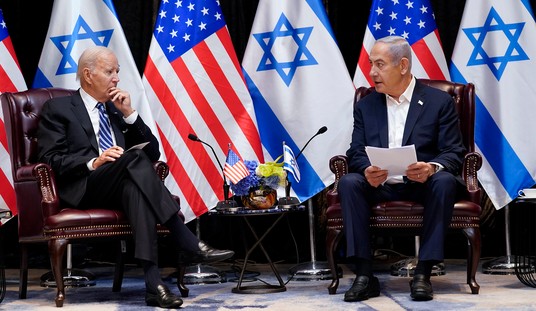Fifty miles is four times farther than the Japanese government’s evacuation radius and roughly one-third the distance between Fukushima and Tokyo. If you want to see what it looks like on a map, click here. A good question from Jake Tapper: Does this mean the White House thinks the threat from the leak is more dire than Japanese officials are letting on?
No answer.
White House press secretary Jay Carney acknowledged that “the advice is no longer in agreement,” but refused to make any judgment on the information and recommendations being made by the government of Japan, a close US ally.
Carney told reporters that while initially the U.S. agreed with the Japanese government’s 20 km recommendation, today, “based on our independent analysis of the deteriorating situation — we all have watched on television and read about the damage at the various reactors and the potential for emissions — based on that new information, the new data and the independent analysis, the NRC is now advising an evacuation beyond a 50-mile radius.”…
Does the US have higher standards?
“It’s not about high or low,” Carney said. “I’m just simply saying that this is our advice based on the information that we have.”
It’s less a question of different standards, I think, than different capacities. Evacuating Americans in Japan within a 50-mile radius is easy; evacuating the much greater number of Japanese is … not. It’s no different, really, from Japan’s decision to suddenly raise the legal limits of radiation to which workers can be exposed. There are new facts on the ground and so Japanese policy is flexing to accommodate them.
The good news, even as visitors scramble to leave the country, is that there may at last be light at the end of this black, radioactive tunnel. TEPCO says a new power line to the plant is almost finished and should be online soon. Assuming that the cooling systems are still structurally sound and that the damage to the containment vessels will still allow steam to be vented, that should finally, finally stop the heating inside the reactors and in the cooling ponds where the spent fuel rods are stored. The crisis would be over, even though months of clean-up would remain. Just one question: Is it too late?
Gregory Jaczko, the chairman of the commission, said in Congressional testimony that the commission believed that all the water in the spent fuel pool at the No. 4 reactor of the Fukushima Daiichi Nuclear Power Station had boiled dry, leaving fuel rods stored there completely exposed. As a result, he said, “We believe that radiation levels are extremely high, which could possibly impact the ability to take corrective measures.”
If his analysis is accurate and Japanese workers have been unable to keep the spent fuel at that inoperative reactor properly cooled — covered with water at all times — radiation could make it difficult not only to fix the problem at reactor No. 4, but to keep workers at the Daiichi complex from servicing any of the other crippled reactors at the plant…
Earlier in the day, Japanese authorities announced another escalation of the crisis at Daiichi when they said that a second reactor unit at the plant may have suffered damage to its primary containment structure and appeared to be releasing radioactive steam.
I haven’t seen any stories lately on the current radiation levels at the plant, so I’m not sure what Jaczko means by “extremely high.” There are typically spikes whenever a containment building explodes or steam is released, but after the spike things drop back to elevated yet low-ish levels. What he’s talking about, it sounds like, is a steady dose of radiation in high levels pulsing off those spent fuel rods. Has anyone seen anything to confirm that? If so, please e-mail us at our tips address and I’ll update.
Since power hasn’t been restored yet, the next line of defense apparently involves sending police trucks to the plant to spray down the fuel rods with water cannons to try to keep them cool. Expect another update by 9 p.m. or so, after Japan wakes up and is briefed on the damage and the Times files its now-nightly report of the impending apocalypse at Fukushima. While we wait, here’s a nice factoid for you to chew on: Apparently, the single riskiest nuclear plant in the United States is located at Indian Point on the Hudson River, just 30 or so miles north of New York City. Quote: “At a 1 in 10,000 chance of core breach, that’s right on the verge of what the [Nuclear Regulatory Commission] calls ‘immediate concern regarding adequate protection.'” And just to double your fun, bear in mind that Khaled Sheikh Mohammed admitted to an Al Jazeera reporter shortly after 9/11 that Al Qaeda had considered targeting U.S. nuclear facilities — which almost certainly means Indian Point — before settling on the World Trade Center. With the entire world watching Fukushima right now, how attractive a target do you think IP must be for jihadis looking to strike big?
Update: Another disagreement between Japan and the U.S.: Contrary to Jaczko’s claim, Japanese officials say that not all the water in the cooling pool for the spent fuel rods at reactor four has boiled off. Presumably Jaczko’s getting his info from American observers at the scene, so what this amounts to is an accusation that the Japanese government is lying about how bad things are.
Update: Those “extremely high” levels of radiation must be pretty extreme if they’re now taking this step:
The United States is deploying additional radiation monitors on Hawaii and other U.S. islands even though it does not expect harmful levels of radiation from damaged Japanese nuclear power plants to reach U.S. soil, environmental regulators said.
The Environmental Protection Agency without fanfare posted a notice on its website on Tuesday of plans to “work with its federal partners to deploy additional monitoring capabilities to parts of the western U.S. and U.S. territories.”








Join the conversation as a VIP Member